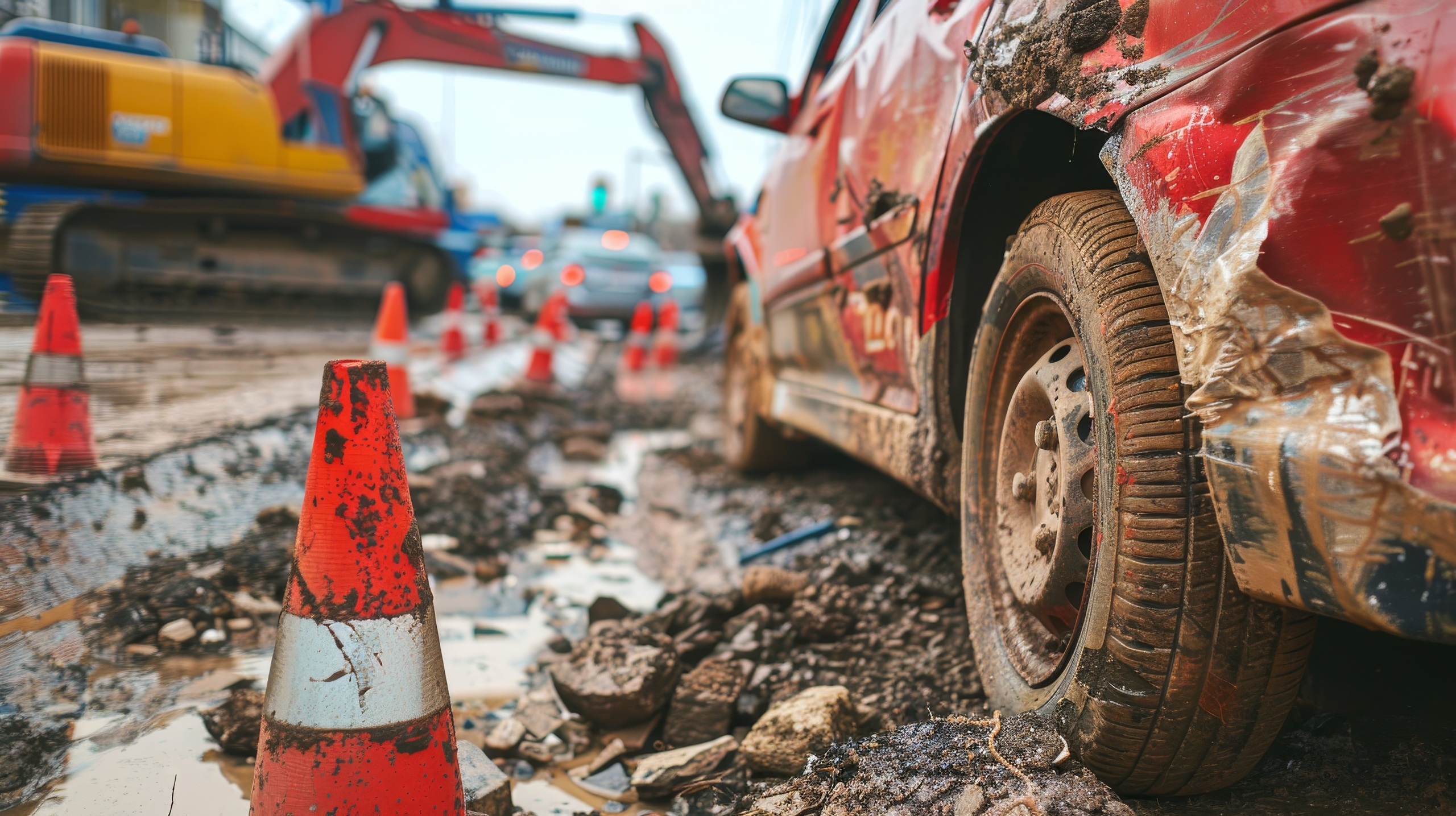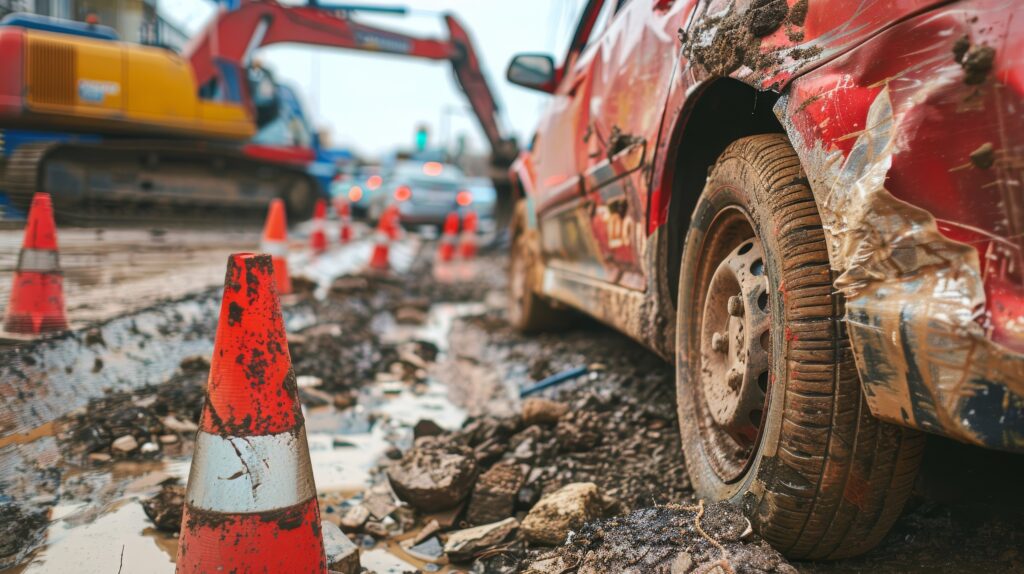Florida Car Accidents Caused by Road Hazards or Construction
Florida’s roads are constantly evolving. Between population growth, aging infrastructure, and frequent roadwork, it’s no surprise that drivers frequently encounter unsafe conditions. These hazards — including construction debris, loose gravel, and missing warning signs — often lead to dangerous accidents.
But when you crash due to a road hazard or an unsafe construction zone, who is legally responsible? Is it the city? The state? A private contractor?
This guide walks you through the legal landscape of road hazard liability in Florida, including what qualifies as negligence, how fault is shared, and what steps to take after an accident.
What Is a Road Hazard Accident?
A road hazard accident occurs when a driver crashes due to unsafe road conditions — not because of another vehicle. These accidents often involve a failure to maintain safe infrastructure, like potholes, uneven pavement, or debris in active travel lanes.
How These Accidents Happen
Such crashes can result from issues like improperly marked construction zones, barriers placed too close to open lanes, materials spilled from trucks, or loose gravel scattered across highways. If not addressed quickly and clearly marked, these hazards pose major risks to public safety.
Who’s Responsible for Maintenance?
Responsibility usually lies with the Florida Department of Transportation (FDOT) for state highways, while local municipalities handle city or county roads. In many cases, the state or city hires private contractors or subcontractors to perform roadwork, signage, or cleanup — and they too may be held liable if they fail in their duties.
What Legally Qualifies as a Hazard?
Preventable and Foreseeable Conditions
For a road condition to be legally actionable, it typically must be preventable and foreseeable. In other words, the party responsible should have known about the danger and taken action to prevent harm.
Examples of Legal Road Hazards
Legally actionable conditions might include unmarked lane closures, debris from construction activity, or missing detour signs. Even a poorly patched section of asphalt or faded lane paint could qualify if it leads to a crash.
However, sudden conditions like a tree falling moments before impact may not qualify — unless authorities failed to respond in a timely manner.
Construction Zone Accidents and Legal Fault
Construction Zones Are High-Risk Areas
In Florida, construction zones are frequent and often span busy interstates and city roads. These zones must follow strict safety protocols, including proper signage, lighting, detour instructions, and reflective barriers.
When these safeguards are missing or improperly managed, the risk of an accident increases — and so does the likelihood of a liability claim.
Common Crash Scenarios
Drivers may swerve or stop abruptly due to unexpected road changes, missing signs, or construction materials on the road. Accidents often occur when traffic patterns suddenly shift without clear warning, or when debris is left behind after a work shift.
In these cases, fault often lies with the contractor, subcontractor, or government agency that failed to meet safety standards.
Determining Liability: Government vs. Contractor
Who Can Be Held Responsible?
In Florida, liability can fall on:
- The Florida Department of Transportation, for state roads
- A city or county, for municipal roads
- A contractor or subcontractor, for poor signage, improper lane closures, or failing to clear debris
Sometimes, multiple parties share fault — for instance, if a contractor failed to follow protocol and the city failed to inspect the site.
Shared Liability in Florida
Florida’s laws allow you to pursue claims against more than one party. If both a government agency and a private company contributed to unsafe conditions, both can be named in a lawsuit. A thorough investigation will be needed to document who did what — or failed to act.
Can You Sue the State of Florida or FDOT?
Yes — But With Restrictions
Florida has waived sovereign immunity in many cases, allowing people to sue state agencies like the FDOT for negligence. However, the process is not simple.
To sue the state:
- You must file a notice of claim within three years of the accident.
- The agency then has 180 days to review before you can formally sue.
- There are damage caps: $200,000 per person and $300,000 per incident.
- You cannot seek punitive damages or pre-judgment interest.
Legal Representation Is Crucial
Due to these restrictions and procedural requirements, it’s highly recommended to work with an attorney who understands government liability and the nuances of suing public entities.
Florida’s Comparative Negligence Rule
What Is Comparative Negligence?
Florida follows a modified comparative negligence rule. This means you can still recover compensation even if you’re partly at fault — as long as you are no more than 50% responsible.
For example, if you’re found 20% at fault and your total damages are $100,000, you can recover $80,000. But if you’re more than 50% at fault, you are barred from any recovery under Florida’s updated law.
Why This Matters in Road Hazard Cases
In cases involving poor signage or road debris, insurance companies and defendants may argue that you could have avoided the hazard. It’s essential to have strong evidence that shows you acted reasonably and that the other party’s negligence was the primary cause of the crash.
Steps to Take After a Road Hazard or Construction Accident
1. Secure the Scene and Call for Help
Your first priority should be safety. Pull over, call 911, and seek medical attention. Even if injuries seem minor, documentation is critical.
2. Document Everything
Take photos of the road hazard, your injuries, damage to your vehicle, and any nearby signage (or lack thereof). Note the time, location, and weather conditions. If witnesses are available, get their names and statements.
3. File a Police Report and Seek Legal Counsel
A police report adds credibility to your claim. Then, contact an experienced personal injury attorney who can help you build a case, investigate the site, and identify liable parties.
Case Study: Contractor Found Liable
A Florida driver was injured after hitting a metal beam left on an active travel lane near a construction zone. The area lacked cones, lights, or warning signs. Investigators discovered that a subcontractor had failed to clear materials at the end of the workday.
The court ruled that the contractor was fully liable for the unsafe conditions. The driver was awarded more than $450,000 in damages. This real-world case highlights how negligent site management can result in serious consequences for construction firms.
Frequently Asked Questions
Who is responsible for removing road debris in Florida?
Responsibility for removing road debris depends on where the incident occurs and what caused the hazard. On state-maintained roads and highways, the Florida Department of Transportation (FDOT) typically oversees cleanup and maintenance. On city or county roads, the local municipality is responsible. However, if the debris results from an ongoing construction project, the contractor or subcontractor working on that project may be held liable for failing to maintain a safe work site and properly clear the roadway.
Can I file a claim if I was the only driver involved in the accident?
Yes, even if no other vehicles were involved, you may still have a valid claim if the accident was caused by unsafe road conditions that resulted from negligence. Many road hazard claims involve single-vehicle accidents where the crash was caused by debris, poor road maintenance, or improperly managed construction zones. The fact that another driver wasn’t involved doesn’t negate your right to compensation if a government entity or contractor failed in their duty to ensure road safety.
Is it possible to sue the Florida Department of Transportation (FDOT) or a city government?
Yes, it is possible to sue the FDOT or a local government entity in Florida, but special procedures apply. The state has waived its sovereign immunity for certain negligence claims, which allows you to file a lawsuit under strict conditions. You must first submit a formal notice of claim within three years of the incident. After that, the government agency has 180 days to investigate the claim. You cannot file a lawsuit until this investigation period has ended. Additionally, compensation in such cases is capped, and you are not allowed to seek punitive damages. Because these cases are complex, legal representation is highly recommended.
How does Florida’s comparative negligence law affect my case?
Florida follows a modified comparative negligence rule. If you are found partially responsible for the accident, the amount of compensation you are entitled to will be reduced by your percentage of fault. For example, if your total damages are $100,000 and you are determined to be 25% at fault, your recovery would be limited to $75,000. Under Florida’s current law, if you are more than 50% at fault, you are not eligible to recover damages at all. This rule makes it crucial to gather strong evidence showing that another party’s negligence was primarily responsible for the crash.
What type of evidence do I need to support my claim?
The more documentation you can provide, the stronger your claim will be. Essential evidence includes photographs of the accident scene, the road hazard, and your damaged vehicle. Medical records, repair estimates, and a copy of the police report also play an important role in substantiating your case. If there were witnesses, their contact information and statements can add credibility to your version of events. In some cases, dashcam footage or surveillance video may be available to support your claim. An attorney can help you gather and organize this evidence to build a compelling case.
Final Thoughts: Understand Your Rights and Take Action
Unsafe road conditions, poor construction zone management, and unmarked hazards are not just inconveniences — they can lead to serious, life-altering accidents. If you’ve been injured due to someone else’s failure to maintain safe roadways, you have a right to pursue justice.
Florida’s laws provide pathways to hold government agencies and private contractors accountable — but those pathways are complex. The sooner you begin gathering evidence and consulting legal counsel, the stronger your claim will be.
Contact Lawlor, White & Murphey Today
If you’ve been hurt in an accident involving road debris, loose gravel, or construction zone hazards, don’t wait to get the legal guidance you need. A qualified Florida personal injury attorney can help you identify the responsible party, collect necessary documentation, and fight for the compensation you deserve.
Schedule your free consultation today and take the first step toward holding the right people accountable.

